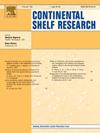Assessing the sources of organic matter in sediments from the Gulf of Batabanó (Cuba) using stable isotopes, aliphatic and polycyclic aromatic hydrocarbons
IF 2.2
3区 地球科学
Q2 OCEANOGRAPHY
引用次数: 0
Abstract
Samples of superficial sediments collected along the Gulf of Batabanó, Cuba were analysed for the first time to characterize contents of biogenic and anthropogenic hydrocarbon biomarkers aiming to understand sources of hydrocarbon contamination that might contribute to biodiversity loss and fisheries decline. Total Petroleum Hydrocarbon (TPH) levels, ranging from 7.8 to 54 μg g−1 dry weight, fall within the range typical for non-polluted areas, suggesting minimal anthropogenic impact. The sediment's aliphatic hydrocarbon profile further supports this, showing no signs of petrogenic contamination and a variation in total ∑n-alkanes concentration between 0.31 and 8.2 μg g−1 dry weight. The presence of high concentrations of highly branched isoprenoids (HBIs), ββ hopanoid compounds, and the absence of the C32-C35 extended hopane doublets, which are indicative of crude oil pollution, point to a dominance of natural organic sources. This is corroborated by δ13C isotopic values of specific aliphatic biomarkers, which trace back to biogenic origins such as terrestrial plant waxes, seagrass beds, and marine plankton, with the seagrass beds being the primary contributor to the organic matter in offshore sediments. Lastly, the low-level presence of polycyclic aromatic hydrocarbons (PAHs) and their pyrolytic origin pattern suggest limited contamination, likely from combustion processes rather than direct petroleum input. This comprehensive analysis underscores the importance of ongoing monitoring to preserve the ecological integrity of such marine environment.
利用稳定同位素、脂肪族和多环芳烃评估Batabanó(古巴)湾沉积物中有机物的来源
首次分析了古巴Batabanó湾沿岸收集的浅层沉积物样本,以表征生物源和人为碳氢化合物生物标志物的含量,旨在了解可能导致生物多样性丧失和渔业衰退的碳氢化合物污染来源。总石油烃(TPH)水平在7.8 ~ 54 μg−1干重范围内,属于非污染地区的典型范围,表明人为影响最小。沉积物的脂肪烃剖面进一步支持了这一观点,没有显示出岩石污染的迹象,总∑正构烷烃浓度在0.31 ~ 8.2 μg−1干重之间变化。高支化类异戊二烯(hbi)和ββ藿烷类化合物的存在,以及C32-C35扩展藿烷双联体的缺失,表明原油污染的特征,表明天然有机来源占主导地位。特定脂肪族生物标志物的δ13C同位素值证实了这一点,这些生物标志物可追溯到陆生植物蜡、海草床和海洋浮游生物等生物成因,海草床是近海沉积物有机质的主要贡献者。最后,多环芳烃(PAHs)的低水平存在及其热解来源模式表明污染有限,可能来自燃烧过程而不是直接石油输入。这项全面的分析强调了持续监测以保持这种海洋环境的生态完整的重要性。
本文章由计算机程序翻译,如有差异,请以英文原文为准。
求助全文
约1分钟内获得全文
求助全文
来源期刊

Continental Shelf Research
地学-海洋学
CiteScore
4.30
自引率
4.30%
发文量
136
审稿时长
6.1 months
期刊介绍:
Continental Shelf Research publishes articles dealing with the biological, chemical, geological and physical oceanography of the shallow marine environment, from coastal and estuarine waters out to the shelf break. The continental shelf is a critical environment within the land-ocean continuum, and many processes, functions and problems in the continental shelf are driven by terrestrial inputs transported through the rivers and estuaries to the coastal and continental shelf areas. Manuscripts that deal with these topics must make a clear link to the continental shelf. Examples of research areas include:
Physical sedimentology and geomorphology
Geochemistry of the coastal ocean (inorganic and organic)
Marine environment and anthropogenic effects
Interaction of physical dynamics with natural and manmade shoreline features
Benthic, phytoplankton and zooplankton ecology
Coastal water and sediment quality, and ecosystem health
Benthic-pelagic coupling (physical and biogeochemical)
Interactions between physical dynamics (waves, currents, mixing, etc.) and biogeochemical cycles
Estuarine, coastal and shelf sea modelling and process studies.
 求助内容:
求助内容: 应助结果提醒方式:
应助结果提醒方式:


